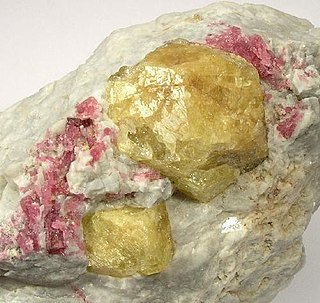 W
WThe borate minerals are minerals which contain a borate anion group. The borate (BO3) units may be polymerised similar to the SiO4 unit of the silicate mineral class. This results in B2O5, B3O6, B2O4 anions as well as more complex structures which include hydroxide or halogen anions. The [B(O,OH)4]− anion exists as well.
 W
WAzoproite is a rare manganese iron borate mineral with the chemical formula (Mg,Fe2+)2(Fe3+,Ti,Mg)(BO3)O2. It was first identified near Lake Baikal, Russia. It was named after the Association pour l'Etude Géologique des Zones Profondes de l'Ecorce Terrestre, whose acronym is AZOPRO in Russian.
 W
WBakerite is the common name given to hydrated calcium boro-silicate hydroxide, a borosilicate mineral (chemical formula Ca4B4(BO4)(SiO4)3(OH)3·(H2O)) that occurs in volcanic rocks in the Baker, California area. Discredited mineral: IMA2016-A.
 W
WBéhierite is a very rare mineral, a natural tantalum borate of the formula (Ta,Nb)BO4. Béhierite is also one of the most simple tantalum minerals. It contains simple tetrahedral borate anions, instead of more common among minerals, planar BO3 groups. It forms a solid solution with its niobium-analogue, schiavinatoite. Both have zircon-type structure (tetragonal, space group I41/amd) and are found in pegmatites. Béhierite and holtite are minerals with essential tantalum and boron.
 W
WBerborite is a beryllium borate mineral with the chemical formula Be2(BO3)(OH,F)·(H2O). It is colorless and leaves a white streak. Its crystals are hexagonal to pyramidal. It is transparent and has vitreous luster. It is not radioactive. Berborite is rated 3 on the Mohs Scale.
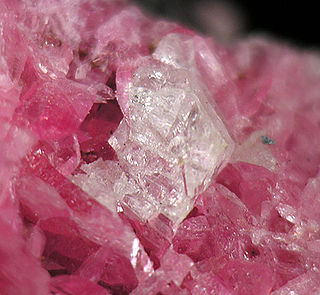 W
WCahnite (Cahnit in German, Cahnita in Spanish, Канит in Russian) is a brittle white or colorless mineral that has perfect cleavage and is usually transparent. It usually forms tetragonal-shaped crystals and it has a hardness of 3 mohs. Cahnite was discovered in the year 1921. It was named Cahnite to honor Lazard Cahn (1865–1940), who was a mineral collector and dealer. It is usually found in the Franklin Mine, in Franklin, New Jersey. Until the year 2002, when a sample of cahnite was found in Japan, that was the only known place that cahnite was located. The geological environment that it occurs in is in pegmatites cutting a changed zinc orebody. The chemical formula for cahnite is Ca2B[AsO4](OH)4. It is made up of 26.91% calcium, 3.63% boron, 25.15% arsenic, 1.35% hydrogen, and 42.96% oxygen. It has a molecular weight of 297.91 grams. Cahnite is not radioactive. Cahnite is associated with these other minerals: willemite, rhodonite, pyrochroite, hedyphane, datolite, and baryte.
 W
WCanavesite, Mg2(HBO3)(CO3)∙5H2O, is a rare carboborate mineral from the abandoned Brosso mine in Italy. Canavesite is a secondary mineral that occurs due to the weathering of ludwigite-magnetite skarn on the surface of mine walls. The physical properties consist of milky-white rosette-like aggregates of elongated transparent fibers shown in figure one. It has the crystal symmetry of a monoclinic with a diffraction symbol of 2/mP-/-.
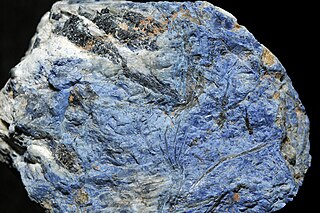 W
WDumortierite is a fibrous variably colored aluminium boro-silicate mineral, Al7BO3(SiO4)3O3. Dumortierite crystallizes in the orthorhombic system typically forming fibrous aggregates of slender prismatic crystals. The crystals are vitreous and vary in color from brown, blue, and green to more rare violet and pink. Substitution of iron and other tri-valent elements for aluminium result in the color variations. It has a Mohs hardness of 7 and a specific gravity of 3.3 to 3.4. Crystals show pleochroism from red to blue to violet. Dumortierite quartz is blue colored quartz containing abundant dumortierite inclusions.
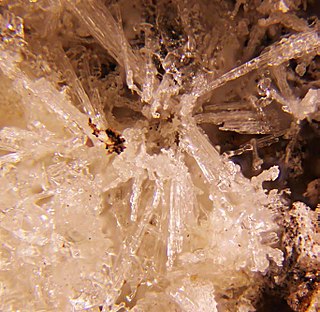 W
WFluoborite has a chemical formula of Mg3(BO3)(F,OH)3. Its name comes from its main chemical components, FLUOrine and BORon. It was first described in 1926.
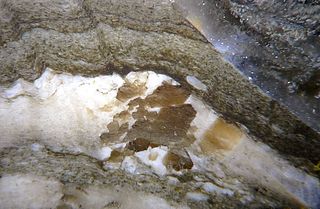 W
WFontarnauite is a relatively recently described, rare sulfate, borate mineral with the chemical formula (Na,K)2(Sr,Ca)(SO4)[B5O8(OH)]·2H2O. It is found in an evaporite boron deposit. It coexists with other evaporite boron minerals, especially probertite. It is monoclinic, crystallizing in the space group P21/c.
 W
WJadarite is a white, earthy monoclinic silicate mineral, whose chemical formula is LiNaSiB3O7(OH) or Na2OLi2O(SiO2)2(B2O3)3H2O.
 W
WJeremejevite is a rare aluminium borate mineral with variable fluoride and hydroxide ions. Its chemical formula is Al6B5O15(F,OH)3.
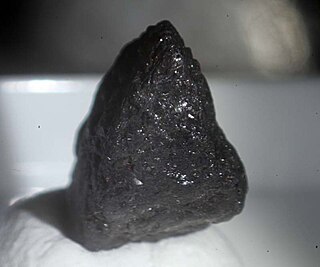 W
WLucchesiite is a new member of tourmaline-group of minerals. Lucchesiite has the formula CaFe3Al6(Si6O18)(BO3)3(OH)3O. It is the calcium and oxygen-analogue of schorl. It has two co-type localizations, one in Czech Republic and the other in Sri Lanka. As the other members of the tourmaline group, it is trigonal.
 W
WLudwigite is a magnesium-iron borate mineral: Mg2FeBO5.
 W
WPainite is a very rare borate mineral. It was first found in Myanmar by British mineralogist and gem dealer Arthur C.D. Pain who misidentified it as ruby, until it was discovered as a new gemstone in the 1950s. When it was confirmed as a new mineral species, the mineral was named after him. Due to its rarity, painite can cost in the range of between US$50,000 to $60,000 per carat.
 W
WPerettiite-(Y) is a complex silicate–borate mineral with the formula Y2Mn4FeSi2B8O24. It was first discovered in 2015 by Adolf Peretti of the Gemresearch Swisslab (GRS). It was found as inclusions in a phenakite crystal from Mogok, Myanmar.
 W
WPinnoite is a magnesium borate mineral with formula: MgB2O(OH)6 or MgB2O4·3(H2O). It crystallizes in the tetragonal crystal system and occurs as colorless to yellow or light green radial fibrous clusters and rarely as short prismatic crystals.
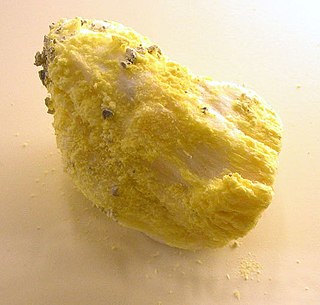 W
WSassolite is a borate mineral, and is the mineral form of boric acid. It occurs in volcanic fumaroles and hot springs, as well as in bedded sedimentary evaporite deposits.
 W
WSchiavinatoite is a very rare mineral, a natural niobium borate of the formula (Nb,Ta)BO4. Schiavinatoite is classified as monoborate. It contains tetrahedral borate anion instead of planar BO3 group, which is more common among minerals. Schiavinatoite is one of the most simple niobium minerals. It forms a solid solution with its tantalum-analogue, béhierite. Both minerals possess zircon-type structure (tetragonal, space group I41/amd) and occur in pegmatites. Schiavinatoite and nioboholtite are minerals with essential niobium and boron.
 W
WSeamanite, named for discoverer Arthur E. Seaman, is a rare manganese boron phosphate mineral with formula Mn3[B(OH)4](PO4)(OH)2. The yellow to pink mineral occurs as small, needle-shaped crystals. It was first discovered in 1917 from a mine in Iron County, Michigan, United States and identified in 1930. As of 2012, seamanite is known from four sites in Michigan and South Australia.
 W
WSearlesite is a sodium borosilicate mineral, with the chemical formula NaBSi2O5(OH)2. It was discovered in 1914 at Searles Lake, California, and was named to honor John W. Searles (16 November 1828 - 7 October 1897), California pioneer, who drilled the well that yielded the first known Searlesite.
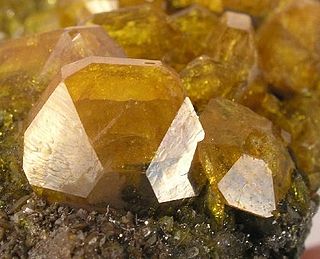 W
WSturmanite is a rare sulfate mineral with the chemical formula Ca6Fe3+2(SO4)2.5(B(OH)4)(OH)12 · 25 H2O. It crystallises in the tetragonal system and it has a Moh's hardness of 2.5. Sturmanite has a bright yellow to amber colour and falls in the ettringite group. It was named after Bozidar Darko Sturman (born 1937), Croatian-Canadian mineralogist and Curator Emeritus of Mineralogy, Royal Ontario Museum.
 W
WTienshanite, named for the Tian Shan Range in Mongolia, is a rare borosilicate mineral, though rock-forming in some parts of its original locality at the Dara-i-Pioz Glacier in Tajikistan. Its formula is extremely complex: KNa3(Na,K,[])6(Ca,Y,RE)2Ba6(Mn2+,Fe2+,Zn,Ti)6(Ti,Nb)6Si36B12O114[O5.5(OH,F)3.5]F2.
 W
WTusionite is a rare colorless to transparent to translucent yellow brown trigonal borate mineral with chemical formula: MnSn(BO3)2. The mineral is composed of 18.86% manganese, 40.76% tin, 7.42% boron, and 32.96% oxygen. It is a late stage hydrothermal mineral and occurs rarely in granite pegmatites in miarolitic cavities.
 W
WWarwickite is an iron magnesium titanium borate mineral with formula: (MgFe)3Ti(O, BO3)2 or Mg(Ti,Fe3+, Al)(BO3)O. It occurs as brown to black prismatic orthorhombic crystals which are vitreous and transparent. It has a Mohs hardness of 3 to 4 and a specific gravity of 3.36.
 W
W